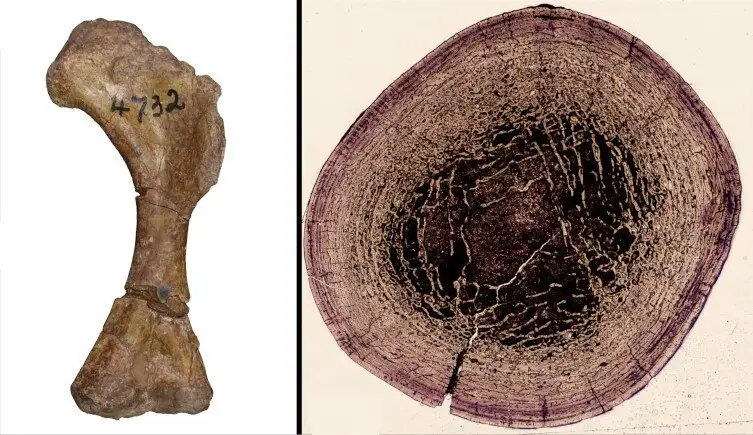In a groundbreaking discovery, a diminutive relative of titanosaurs has been unearthed in South Africa. This remarkable dinosaur, weighing a mere 75 kilograms, barely surpasses the average weight of a human. Initially, paleontologists believed that the fossil belonged to a juvenile Massospondylus due to its small size. However, fresh analysis has unveiled a startling revelation: the fossil represents not a young individual but quite possibly an entirely unknown species of dinosaur.
Although insufficient evidence presently exists to assign a new species name, this remarkable find signifies a significant shift in our understanding of sauropodomorphs and their sauropod kin. The fossil’s bone structure indicates that these early sauropodomorphs could achieve such diminutive proportions, challenging the previous assumption that the smallest skeletons were merely juvenile specimens.
Dr. Kimberley Chapelle, the lead author of the study examining this fossil, elaborates, “Until now, we were unaware that early sauropodomorphs could attain such small sizes, leading us to assume that the smallest skeletons were those of juveniles. By reevaluating these southern African discoveries, we hope to uncover a more complete specimen that will enable us to christen a new species.”
The research unveiling these remarkable findings has been published in the prestigious journal Royal Society Open Science.
How was the smallest sauropodomorph discovered?
Back in 1978, a remarkable fossil was unearthed in South Africa, within rocks that originated from the Lower Jurassic period, spanning approximately 201 to 174 million years ago. The specific region where the discovery took place forms part of the Massospondylus Assemblage Zone, a designation given due to the frequent occurrence of Massospondylus dinosaurs in that area.

The connection between the abundance of Massospondylus dinosaurs and the Triassic-Jurassic mass extinction event, one of the most significant extinctions in history, has long been held as a prevailing theory. It was believed that these resilient dinosaurs thrived in the aftermath of the extinction, capitalizing on the lack of competition to dominate the Early Jurassic ecosystems in what is now South Africa.
However, recent research has cast doubt on this hypothesis. In 2019, the researchers involved in the present study were part of a team that realized not all fossils attributed to Massospondylus were what they seemed.
“The initial description of Massospondylus dates back to 1854, and it was one of the first dinosaurs discovered in South Africa,” explains Kimberley. “During that time, there were limited comparative specimens of early sauropodomorphs, and a comprehensive description of this species’ skeleton was only published in 2019.”
Consequently, for a considerable period, any early sauropodomorph fossils found in the Early Jurassic strata of South Africa were automatically classified as Massospondylus.
This reassessment of Massospondylus led to the reclassification of certain malformed bones as belonging to a distinct and previously unknown sauropodomorph species, now named Ngwevu intloko.
However, while describing Ngwevu, the researchers had a suspicion that many other specimens labeled as Massospondylus in various collections over the years might actually represent other unidentified dinosaur species. Rather than a solitary species prevailing and dominating the post-extinction landscape, it appeared that a diverse array of sauropodomorphs thrived across southern Africa.
Their hunch has now been vindicated during their investigation of a fossil humerus, bearing the somewhat memorable name BP/1/4732.
What was the smallest sauropodomorph like?
During their study on the growth patterns of early sauropodomorphs, the research team embarked on a meticulous examination of bone fragments extracted from a range of fossils. Among these samples, a particularly intriguing distinction emerged when they analyzed the bone section obtained from BP/1/4732: it displayed notable dissimilarities compared to those of Massospondylus.

A significant disparity observed between the mystery arm bone and Massospondylus and other contemporary dinosaurs was the presence of lines of arrested growth (LAGs), resembling tree rings in bone. LAGs form when growth slows down, such as during dry seasons, and the occurrence of numerous LAGs in close succession indicates an external fundamental system (EFS), suggesting the cessation of growth.
Dr. Kimberley Chapelle explains, “In Massospondylus, we have only observed an EFS with four LAGs in the bones of a single individual. However, the arm bone we examined exhibited an EFS with 11 LAGs, indicating a more advanced stage of development.”
Comparative analysis of the size of the enigmatic arm bone with that of Massospondylus and other dinosaurs from the same era revealed its significantly smaller proportions. Only Adeopapposaurus possessed a humerus circumference smaller than the mystery fossil, but it is believed to have been a juvenile specimen.
In fact, this newfound fossil is likely the smallest sauropodomorph known from its time, potentially measuring only a few meters in length as an adult. While limited conclusions can be drawn from the arm bone alone, its shape suggests that the unidentified dinosaur likely adopted a bipedal stance, similar to its larger relatives.
The reasons why more small sauropodomorphs did not proliferate in the wake of this discovery remain shrouded in mystery. It could be attributed to factors such as preservation biases or the biological characteristics of the animal itself.
Kimberley remarks, “Some scientists propose that the emergence of small ornithischian dinosaurs like Lesothosaurus in southern Africa during the Jurassic may have outcompeted early sauropodomorphs. However, I find this unlikely, as many similarly sized mammals coexist in comparable ecological niches today. Instead, it is possible that sauropodomorphs lost the ability to remain at such diminutive sizes as part of their evolutionary trajectory toward larger forms, but this remains uncertain.”
While this diminutive dinosaur did not witness the subsequent developments, its distant relatives would evolve to become the largest creatures ever to traverse the Earth, flourishing over the next 100 million years.
Source: Natural History Museum
